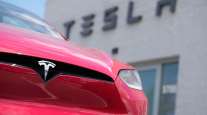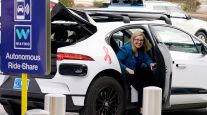Simulated City to Test Self-Driving Cars Opens in Michigan

A simulated city opens July 20 on the north campus of the University of Michigan to test how self-driving cars will travel in the future without mowing down pedestrians or causing colossal crashes.
“We had the faculty here at the university design the fully evolved future,” Peter Sweatman, head of the Transportation Research Institute, which oversaw the creation of the M City test facility, said in an interview. “After all, we’re replacing humans with machines, and those machines need to be able to operate in a full, rich environment.”
Automakers are racing to develop self-driving cars and overhaul their business models for a world where mobility is being redefined as most of the global population crowds into large megacities during the next two decades. Driverless cars that move in harmony may become essential to keep people and goods flowing safely and efficiently.
M City, a 32-acre mini-metropolis, seeks to replicate modern urban chaos with traffic jams and unpredictable pedestrians, alongside suburban streetscapes, superhighways and rural roads. The $6.5 million facility in Ann Arbor, Michigan, has 40 building facades, angled intersections, a traffic circle, a bridge, a tunnel, gravel roads and plenty of obstructed views. There’s even a four-lane highway with entrance and exit ramps.
Sebastian, a mechatronic pedestrian, will step out into traffic to test whether the robot cars will sense him and hit the brakes to avoid running him down, Sweatman said.
“We believe that autonomous technology is going to be extremely attractive to consumers,” Sweatman said. “So it’s going to have to be deployed as quickly as we reasonably and responsibly can. We designed M City to hyper-accelerate the process.”
Sweatman is also director of the Mobility Transformation Center, formed by academic, government and corporate sponsors, including General Motors Co., Ford Motor Co., Toyota Motor Corp., Nissan Motor Co. and Honda Motor Co.
Automakers have said driverless cars may be on the road within five years. The market for autonomous technology will grow to $42 billion by 2025 and self-driving cars may account for a quarter of global auto sales by 2035, according to Boston Consulting Group. By 2017, semi-autonomous cars that operate in auto-pilot mode, park themselves and change lanes automatically will be available in “large numbers,” the firm said.
Truck and engine maker Navistar International Corp. is among the companies participating in the research and development partnership, which is operated by UM’s Mobility Transformation Center.
Navistar said it is a founding member of the MTC’s leadership circle and the only heavy-duty truck manufacturer participating in the initiative. Other member companies include Honda, Ford, General Motors, Qualcomm, State Farm, Toyota and Verizon.
“This is an exciting opportunity for Navistar to leverage our leadership in connected vehicle technologies and collaborate with others in the industry to make connected transportation a reality,” said Denny Mooney, Navistar group vice president of global product development. “The innovation of today’s connected vehicle technologies will drive significant improvements in the way people, goods and services move throughout society—and we’re proud to play an important role in this transformation.”
Navistar moved into the connected-vehicle space in 2013 with the launch of its OnCommand Connection remote diagnostic system, which is currently tracking more than 130,000 trucks and is now a standard offering on all new International trucks.
Until now, tests of autonomous cars have been conducted on public roads or private proving grounds. Automakers study robot cars on old test tracks designed to evaluate how fast traditional cars can run laps or how well they handle with humans at the wheel. Google Inc. has logged more than 1 million miles of testing its self-driving cars on Silicon Valley roads and, as of last month, Austin, Texas, highways.
M City represents an alternative to that.
“If you’re out on the public roadways, certainly all kinds of really unusual things will arise, but they’re only going to arise once,” Sweatman said. “We like the idea of creating challenging situations that we can reproduce as many times as we want.”
Once a technology is proved in M City’s controlled environment, it can be tested on public roads, he said. Automakers and the university already have 3,000 “connected cars” on the roads in Ann Arbor, capable of communicating with one another and with infrastructure such as traffic lights. By 2020, there will be 29,000 connected cars tested on public roads in southeastern Michigan, Sweatman said.
“We also have a simulator that simulates automated vehicles,” he said. “So we can work right across the simulator to M City to Ann Arbor and then to a bigger deployment across southeastern Michigan. We can do rapid cycles of learning right across all those environments.”
Automakers have been eager to take to the roads of M City, Sweatman said.
“We’re trying to imagine what the fully evolved automated future might look like,” he said. “When companies see it, the juices really start to flow, and they have an epiphany when they realize, ‘Wow, I can do that here.’ ”




